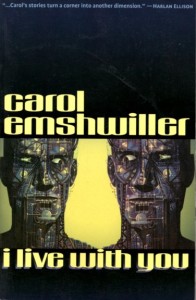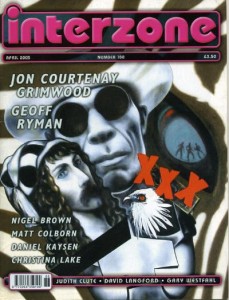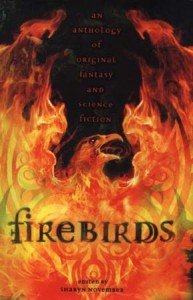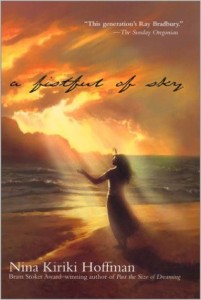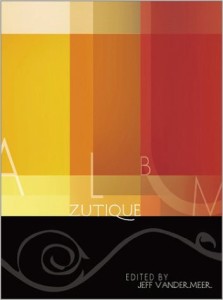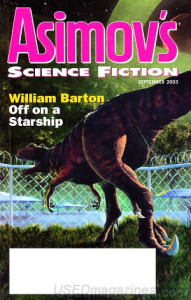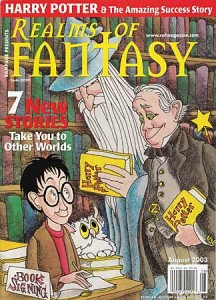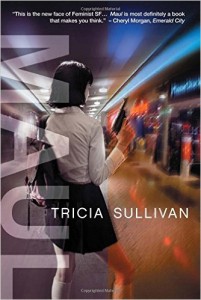The Otherwise Award is pleased to announce that the award ceremony for the 2003 Otherwise Award winner(s) has been held, and the winners have received their award and accolades.
Award Information
Conference Information
- Award Year: 2003
- Award Year Number: Year 13
- Conference: WisCon 28
- Date: 30-05-2004
- Location: Madison, WI
Award Sections
Award Winner
The 2003 jury chose 1 work for the Otherwise Award.
Andy Gage is dead. Andrew Gage, a 26-year-old born two years ago, is in charge of Andy’s body, while his father, Aaron, runs the house he built inside it … The truth, as Set This House in Order‘s characters keep telling one another, is complicated. Andy, Andrew, Aaron and the house’s hundred or so other inhabitants are “alters,” to use a psychiatric term. They are the multiple personalities that arose after repeated incidents of childhood abuse shattered Andy’s sense of self. Instead of attempting to reintegrate them all, Aaron, a dominant personality, has constructed a stable inner landscape, a common gathering spot. The various alter characters act as if it’s a real place, though the concept’s not a scientifically proven model for treatment either inside or outside of the novel. This leads to the book’s slipstream feel. Andrew carefully allots time in control of the body to genteel Aunt Sam, childish Jake, mall-loving Simon and others. The inclusion of both male and female alters in his community of self reflects the experience of real-life multiples and forms a solid basis for Matt Ruff’s daring treatment of gender issues and expectations. — Nisi Shawl A number of books and stories this year did fascinating things with gender and several of them were extremely well written, but Matt Ruff’s Set This House in Order combines literary quality with gender exploration in an unparalleled manner. The subtitle of the book, A Romance of Souls, tells the reader that what s/he’s reading is fantasy-multiple personality syndrome doesn’t really work this way-but everything is so well constructed, so believable, that it becomes difficult to see the book as anything other than a realistic novel concerning the way MPS actually works, or at least would work if the universe were a more remarkable place than it really is. Andy Gage and Penny Driver, the souls who spend the majority of their time as the public faces of the two multiples at the center of this story, are characters we really care about despite, or perhaps because of their various tics and eccentricities. The dozen or so other souls that we get to know over the course of the novel, some of them mere partials, are also well drawn, as are the supposedly normal secondary characters. Ruff’s exploration of what the interior, virtual reality world of a multiple might be like, the “House” of the title, is particularly fascinating. This is a rich and wonderful novel that brings a truly fantastic world to vibrant life. — Michael Marc LevySet This House in Order: A Romance of Souls by Matt Ruff (Harper Collins, 2003)
Work Information
Title: Set This House in Order: A Romance of SoulsAuthor: Matt RuffPublisher:
Publisher Name: Harper CollinsCountry: USYear: 2003
Award Honor List
See full details about the 2003 Honor List
The 2003 jury chose 10 works for the Honor List Carol Emshwiller’s “Boys” is instantly recognizable as feminist dystopian fiction, kin to The Gate to Women’s Country (Tepper), The Wanderground (Gearhart), and Walk to the End of the World (Charnas), but it’s somewhat unusual in that it’s told from a male perspective. The narrator lives up in the mountains with the rest of the men and boys. In the valley below are the villages of the women. The enemy, other men, live in the mountains on the other side of the valley and no one remembers how this state of affairs developed. Once a year the men descend to the valley to copulate with the women and steal the boys who have grown old enough to survive in the mountains. On one such raid, however, things change. The women fight back, badly defeating the men and capturing the narrator. Wounded, he knows he will never survive in the mountains, and must adjust to the idea of living in the women’s world, unsure of what changes the future will bring. What makes “Boys” special is Emshwiller’s decision to strip the story down to its essentials, relating what might well be a novel in another writer’s hands in a brief, parable-like narrative that packs considerable power. — Michael Marc Levy In “Birth Days”, Geoff Ryman uses the diary of a gay man living in the near future to play with, and undermine, ideas of biological and gender determinism. The narrator, a gay male biologist in a future where the genes for sexual orientation have been identified and are being calmly eliminated from most gene pools in the developed world, invents a way for men to bear children. If two men can be the biological parents of a child, and one of them carry the child to term in his own body, what does gender mean? Ryman foregrounds various attempts to find simple explanations for complicated phenomena: Ron’s mother, even knowing better, talks about “the gene” for sexual orientation, and speculates that it might be an alien plot left over from the time of the trilobites. Ron, while sure there’s nothing wrong with him, doesn’t see any reason that eliminating the genes that made him would be a problem. Then he makes his scientific breakthrough, and turns the biological explanations on their heads. Odd myths–virgin births, Athena born from the head of Zeus–are offered as factual evidence, and a heterosexual nurse suggests that heterosexuals, rather than homosexuals, are an “endangered species.” When I first read this story, I wrote “Whatever you’re doing, you find the stories to justify” on the back of the last page. Ryman shows us some of that story-telling, in the difficult area where gender and sexual orientation run into biology and ethics. — Vicki Rosenzweig Kara Dalkey sets her retelling of Hans Christian Andersen’s “Snow Queen” in Japan’s militaristic Kamakura period; as she showers us with gorgeous images written in her paradoxically spare, poetic prose, Dalkey also pierces common assumptions about gender with the sharp insights embedded in “The Lady of the Ice Garden.” Rather than being kidnapped by an overwhelming and amoral feminine power as was Kay, Andersen’s hero, Keiken leaves his home and family voluntarily, driven by a desire to distance himself from all emotion (which he perceives as vulnerability) and drawn to the frigid perfection of the Lady of the Ice Garden, his ideal woman. Following in the footsteps of Andersen’s Gerda, Dalkey’s heroine Girida searches for her childhood friend, but her quest doesn’t end in rescuing him with her tears. She has embarked on an adventure all her own in which she is the subject, the active force, reaping her own rewards. — Nisi Shawl Fudoki interweaves two stories: the title tale-within-a-tale of an orphaned cat who takes to the road and is transformed into a human, and autobiographical reminiscences by the elderly Princess Harueme, who is writing the tortoiseshell woman’s story. In doing so, she reflects on her own life and motivations, and the limitations that both gender and class have imposed on her: she has had luxury, but almost no freedom. The “fudoki” is a cat’s story and her place in the world, in an imagined cat-culture that is entirely female-centered. The cat Kagaya-hime is seen as somehow strange by the humans she travels among, even those who don’t realize that she isn’t human. She in turn regards them as strange, in part because men are so central to family life in medieval Japan. Most of the fantastic elements are in the cat’s tale: Harueme, as she writes, gives her the tools and knowledge she needs for each part of her adventure. The cat’s tale begins in the fire that destroys her home and family. Meanwhile, Harueme is gradually burning all her old diaries, and burning each notebook of Kagaya-hime’s story when she finishes it. At the end of her life, the princess is fleeing a family and structure that have trapped her, seeming glad at least to have never borne a child. Meanwhile, the cat is walking toward a home and family, though she only realizes this at the end of her journey. The female-centered fudoki is a place where motherhood gives her importance and authority, rather than being seen as a trap. — Vicki Rosenzweig Jeanne Les Flambeaux is a loser: can’t ignore the voices in her head; can’t cook, though her mother and father run a famous restaurant; can’t pick a lover without having him steal the family jewels. Her pursuit of Cousin Johnny and the Ruby Scepter becomes a fast-paced Heroine’s Journey of a sort mythologist Joseph Campbell could never have dreamed up. Seeking her animus as countless heroes have sought their anima, Jeanne’s path leads her through a world in which the mundane and supernatural are inextricably linked. Completion, (according to Jung, always the goal in these stories) comes not with the aid of romance, but through introspection and reclamation of repressed history. — Nisi Shawl Gypsum LaZelle, the protagonist of Nina Kiriki Hoffman’s A Fistful of Sky, lives in a family of mages and can’t understand why, at twenty, she’s the only one of her siblings without magic. Feeling inferior, she’s grown up lacking confidence, clothing sense, or, for that matter, a steady boyfriend. Then Gypsum falls terribly ill and, recovering, discovers her magic, the ability to curse. Sounds like something you’ve read before, doesn’t it? But this is Nina Kiriki Hoffman, remember, and Gypsum’s curses turn out to be like no one else’s. First of all there’s the fact that she can’t not curse; if she doesn’t use her power, it builds up in her until curses erupt at random. Then there’s the time that she curses herself with ultimate fashion sense and drives everyone crazy with her dead-on but decidedly unwanted clothing critiques. Hoffmans tale, by turns frightening and hilarious, tracks a young woman’s bumpy path to magical adulthood, allowing her to try on a variety of gender roles as she attempts to find her place in her family and the world. — Michael Marc Levy Note: “Christina X” (sometimes “Christina Flook”) is the fictional author of this introduction to a nonexistent work. A political missive from a world not quite our own, detailing the emergence and politicization of a new gender — the hypersexualized “catgirl,” a sort of walking anime heroine who is irresistably cute and sexy, capriciously independent, and utterly contemptuous of the men who fall for her. A sort of new-millenium wedding of the Victorian woman-child and her deadly vampiric counterpart, the catgirl satirizes certain ideas about women and girls (not just on the part of men — a catgirl could easily grace the next cover of Bust), yet discovers the hidden subversiveness of those very same tropes. Catgirls are infantilized, but they are hardly domesticated — and they’re ready to start a revolution of (not so) little girls. — Lori Selke “The Ghost Girls of Rumney Mill” explores the persistence of gender roles and expectations. Ghosts, by definition, lack bodies; they can barely affect the living, or any other part of the physical world. What they have left is memory and desire. MacDonald’s ghosts are teens and children, believably so. They have separated themselves by gender, and take the separation entirely for granted. Pauline, the narrator, didn’t like boys when she was alive, and doesn’t think death has improved them. When a new boy wants to live with the girls, she rejects him, even though Matthew wants to be Michele, and the boys want no part of a ghost who turned up in a blue dress and insists that he was supposed to be a girl. Pauline gets to know Matthew/Michele slowly, and her developing acceptance of Michele as a girl arises believably as she learns more about Michele’s life and death. In the process, she learns more about herself, and speculates about what is keeping her, and the few other dead youths, trapped in the rundown outskirts of the town. — Vicki Rosenzweig Maul alternates between two story lines. One unfolds in a world where most men have been wiped out in a series of “Y-plagues,” and those that survive are kept penned up like the fragile endangered species they are. They are let out only to compete in large-scale competitons for sperm donor rights by engaging in extreme sports and other acts of hypermasculinity. The second story is set in a suburban shopping “maul” dominated by gangs of armed adolescent girls. Tricia Sullivan exhibits a sharp parodic wit and a healthy irreverence toward gender role expectations both traditional and feminist; her satiric tone in reminiscent of some of the best 70’s feminist science fiction. Best of all, she is fearless enough to delve into the biology of sex and gender — a territory that’s been all but ceded to the evolutionary biologists for the past few years. This is a fast-paced, hugely entertaining novel with enough depth to reward the careful reader, especially those interested in the issues the Tiptree Award was founded to encourage exploration of. — Lori SelkeBoys, Carol Emshwiller (SciFi.com, U.S., 2003)
Birth Days, Geoff Ryman
Lady of the Ice Garden, Kara Dalkey (Firebird Books, U.S., 2003)
Fudoki, Kij Johnson (Tor Books, U.S., 2004)
Coyote Cowgirl, Kim Antieau
A Fistful of Sky, Nina Kiriki Hoffman (Ace Books, U.S., 2002)
The Catgirl Manifesto: An Introduction by Christina X, Richard Calder (Ministry of Whimsy Press, U.S., 2003)
Looking Through Lace, Ruth Nestvold
Work Information
Title: Looking Through LaceAuthor: Ruth NestvoldWork Type: Short FictionCollection:
Title: Isaac Asimov's Science Fiction Magazine September 2003Editor: Gardner DozoisView on ISFDB The Ghost Girls of Rumney Mill, Sandra McDonald (Sovereign Media, U.S., 2003)
Maul, Tricia Sullivan (Orbit, U.K., 2003)
Jurors
- Michael Marc Levy
- Vicki Rosenzweig
- Lori Selke
- Nisi Shawl
- Maureen Kincaid Speller (chair)
Award Ceremony
See full details about the 2003 Ceremony
The 2003 Otherwise Award was given to Matt Ruff at WisCon 28, May 30, 2004, in Madison, Wisconsin.


